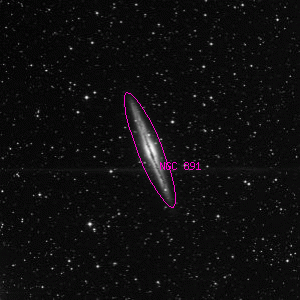NGC 891

Overlaid DSS image of NGC 891, 30' x 30' with north at top and west to the right
Aladin viewer for the region around NGC 891
H V 19, h 218, GC 527, MCG+07-05-046, UGC 1831, PGC 9031
| Type | Galaxy |
|---|---|
| Magnitude | 9.93 |
| Size | 12.3' x 2.45' @ 22° |
| Right Ascension | 2h 22' 32.9" (2000) |
| Declination | 42° 20' 54" N |
| Constellation | Andromeda |
| Description | B, vL, vmE22 |
| Classification | SA(s)b? |
Observing Notes
Andrew Cooper
Dec 8, 2018 Kaʻohe, Mauna Kea, HI (map)
51cm f/4 Newtonian, Obsession #004 @ 58x
Seeing: 7 Transparency: 7 Moon: 0%
A very nice edge-on spiral in a very rich starfield, about 10' x 2', several stars embedded in the halo, a subtle dark lane, no notable core
Andrew Cooper
Oct 25, 2003 Farnsworth Ranch, Pima Co., AZ (map)
46cm f/4.5 Deep Violet
Perfect edge-on spiral in a thick winter galactic star field, very elongated N-S, central lane prominent along most of the length, central bulge twice as wide as the tapering outer disk, no actual core visible
Captain William Henry Smyth
Oct 12, 1836 No. 6 The Crescent, Bedford, England (map)
150mm f/17.6 refractor by Tully 1827
An elongated nebula, on the Lady's right foot, where a line from Algol to Al'mak passes under it, at about two-thirds of the distance.
This wonderful object was most indistinctly seen, though watched with a set attention on a glorious night, with the telescope in the highest possible order: yet it was discovered by Miss Herschel in August, 1783, with a Newtonian sweeper of only twenty-seven inches focal length, charged with a magnifying power of 30. [This is incorrect due to a confusion of H V 19 with H V 18 (M110) by William in the appendix to his first catalog, this galaxy was discovered by William Herchel in 1784]
Sir William Herschel describes it as having a black division or chink, in the middle; and in my telescope it is certainly brighter at the edges than along the central part. Sir John Herschel, whose No. 218 it is, has given a beautiful drawing of its aspect in the twenty-foot reflector, and concludes that it is a flat ring, of enormous dimensions, seen very obliquely. It consists, probably, of myriads of solar systems at a most astounding distance from ours, and affords a distinct lesson that we must not limit the bounds of the universe by the limits of our senses.― A Cycle of Celestial Objects Vol II, The Bedford Catalogue, William Henry Smyth, 1844
Other Data Sources for NGC 891
Nearby objects for NGC 891
10 objects found within 60'
| Abell347 | HD 14622 | NGC 898 |
| NGC 906 | NGC 909 | NGC 910 |
| NGC 911 | NGC 912 | NGC 913 |
| NGC 914 |
Credits...
Drawings, descriptions, and CCD photos are copyright Andrew Cooper unless otherwise noted, no usage without permission.
A complete list of credits and sources can be found on the about page
NGC 891